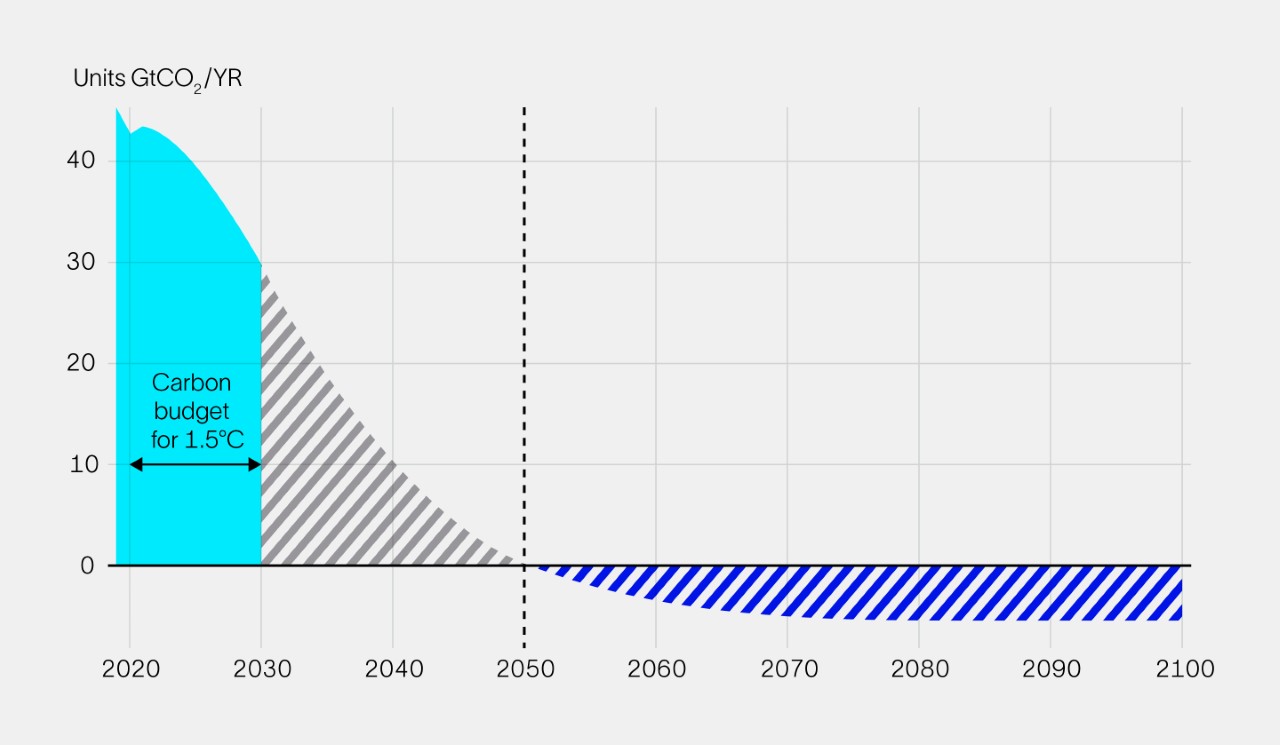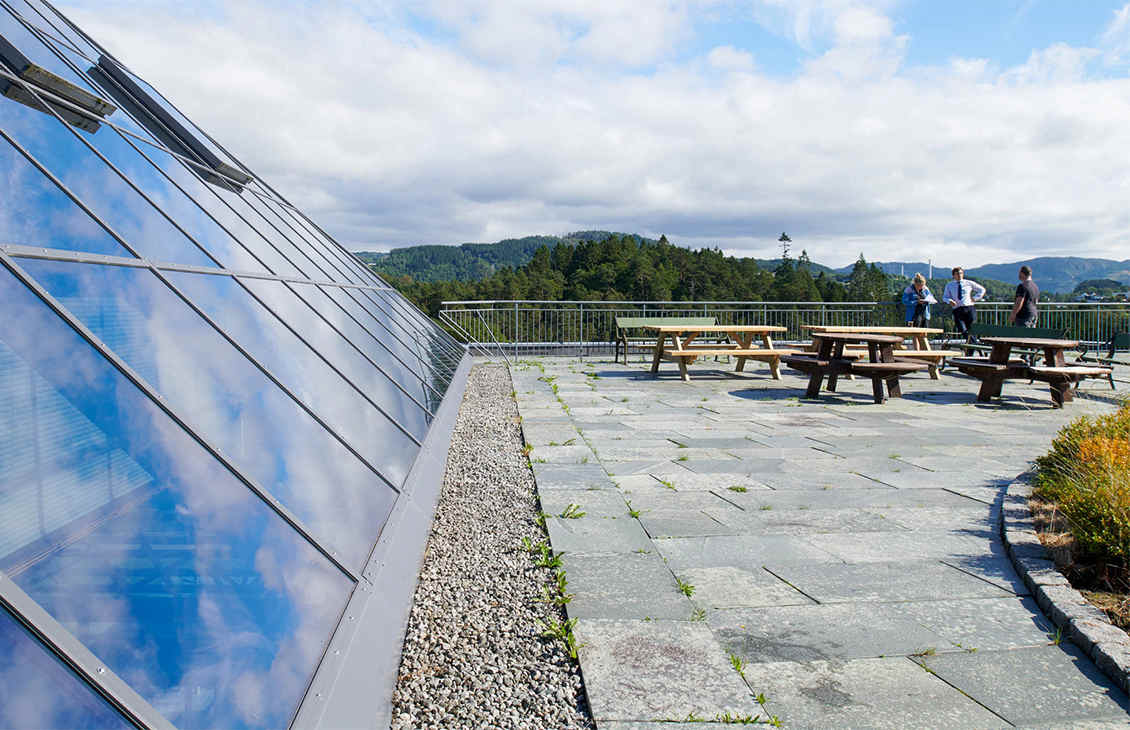In 2015, the Paris Agreement gave the world a carbon budget of 380 gigatons of carbon dioxide (CO2). This budget represents the reduction in carbon dioxide equivalent (CO2e) emissions needed over the coming century to limit the global temperature rise to only 1.5 degC. The carbon budget curve in the image below, however, shows us that we will most likely spend this budget by 2030 and require a recovery course from the 2050 carbon neutrality mark onward.

A step-by-step approach to achieving net zero
Many factors influence this balancing act we’re all now part of, and we have the collective responsibility to reduce our greenhouse gas (GHG) emissions for the planet to thrive. For a more sustainable energy future, we must decarbonize quickly with visible, incremental progress.
But the question remains: How?
1. Reduce Scope 1 and 2 emissions
First, you need to reduce emissions in your own operations, specifically Scopes 1 and 2. This starts with evaluating data to understand where your emissions are coming from. For us, the fuel, natural gas, and diesel that we use in the field make up over 80% of our total Scope 1 and 2 emissions.
Start by determining where fuel is used and reviewing its management processes at your locations. With this kind of data, you can begin looking for ways to increase operational efficiency throughout your own operations. Subsequent areas of action could include reducing vehicle idling, improving job design, or installing auto engine stop-start equipment, as well as considering other equipment upgrades, electrification, and low-carbon fuel alternatives.
For Scope 2, most of your emissions will often come from the electricity used in your facilities. Data quality is fundamental to tracking progress and can be improved by conducting energy data audits to identify anomalies in consumption. Another option is to install a smart energy monitoring system to automate monthly data capture. It’s also possible to gain a better understanding of energy losses and opportunities through energy audits, but this must go hand in hand with encouraging energy-saving behaviors (e.g., shutting off all lights, equipment, and heating/ventilation/air conditioning when not in use) while also tapping into renewable energy sources. By the end of 2022, for example, renewable power accounted for more than 33% of the total electricity consumed in SLB’s facilities. And we’re not the only ones making this shift.
2. Decarbonize customer operations through product innovation
Second, we must accelerate decarbonization through tech that continuously improves efficiency, reliability, and performance for our customers. Energy manufacturers are on the hook for expanding their portfolios to offer products and services built on rigorous technical methodologies for quantifying and reducing emissions. Their partners and communities expect it. These portfolios must address GHG emissions challenges across the spectrum—including (but not limited to) methane emissions, flaring, and construction CO2 footprint—and present solutions for the electrification of infrastructure and full field development.
3. Adopt new energy at scale
Third, we must scale new energy systems. We’re seeing more and more tech and partnerships dedicated to low-carbon, carbon-neutral, or even carbon-negative solutions for the energy systems of the future. These rely heavily on solutions such as low-carbon hydrogen, sustainable battery-grade lithium, stationary energy storage, geoenergy, and geothermal sources. The possibilities are endless. The utilization of a geoenergy installation, for example, has already reduced as much as 90% of the carbon emissions related to the heating and cooling of buildings.
Where to start on your decarbonization journey
There’s still a long way to go, but we’ve already made great progress and learned many lessons along the way. For those who are at the beginning of their decarbonization journey, we suggest you start where we did: Learn the relative impact of different parts of your portfolio by mapping your inventory using the GHG Protocol, which is recognized globally by all industries.
By using the protocol guidance, it’s possible to estimate your carbon footprint and classify your GHG emissions—including customer use-phase emissions—into the appropriate scopes and categories. This enables you to identify which of your technologies have an impact in relation to their design, along with the circumstances of their use. Adopting a science-based approach ensures measurable environmental progress is delivered and enables you to set cohesive but realistic targets from a baseline year.
Having analyzed all 15 categories, you now have a basic standard and can begin formulating your net-zero commitment. Some companies will make a commitment that includes Scope 3 emissions. By incorporating these emissions from across your entire value chain—from customers through to supply chain—you’ll differentiate yourself from your peers and spearhead the sector’s transition and continued relevance.
Be sure to set ambitious interim targets to track progress. And to ensure your emissions targets play a fundamental role in business decisions, try distributing the responsibility for different parts of the inventory across your organization so your teams feel ownership and accountability. Bonus: Set performance objectives based on results so that growth opportunities are weighed against the incremental emissions they contribute.
Achieving net zero on a local AND global level
After this, you can architect your very own targeted emission reduction road maps, ideally supported by a digital emissions tracking system. This enables you to consistently measure your footprint, better understand your priorities (which will vary across the globe), and then act. For example, in some of our geographies, fuel efficiency is key, while in others, it’s access to renewable power that remains the dominant focus.
An effective way of keeping your finger on the pulse of these localizations is to have a dedicated network of sustainability champions that monitors progress, plans and executes high-impact sustainability projects, and drives action on the ground. The strongest way to enhance your sustainability performance is to empower your local teams—they know their landscapes and communities best.
Last, but certainly not least, is the ability to forecast emissions. With a firm understanding of both technology and local environments, you can build out multiple possible scenarios. Not only will you clearly understand the investments required for future endeavors, but you’ll also identify what will be required to get renewable energy access and support for your operations and/or those of your partners.
Remember that decarbonization is a pressing obligation that transcends climate projections and goals. We must all set our bars high for delivering measurable social and environmental progress and remain open to novel partnership models that can accelerate our collective impact. Decarbonizing the planet is an ambitious and complex task, but we as an industry are at the forefront of what needs to happen. And we can make it happen, together.




